
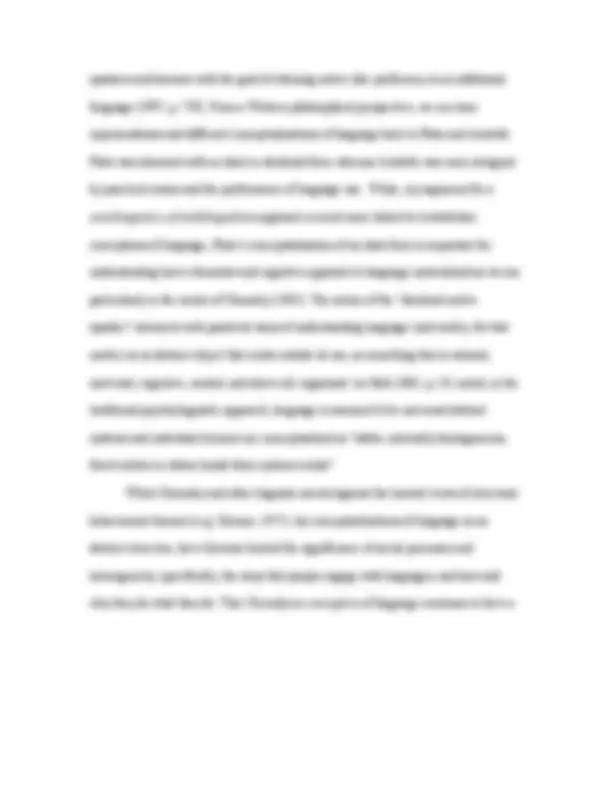
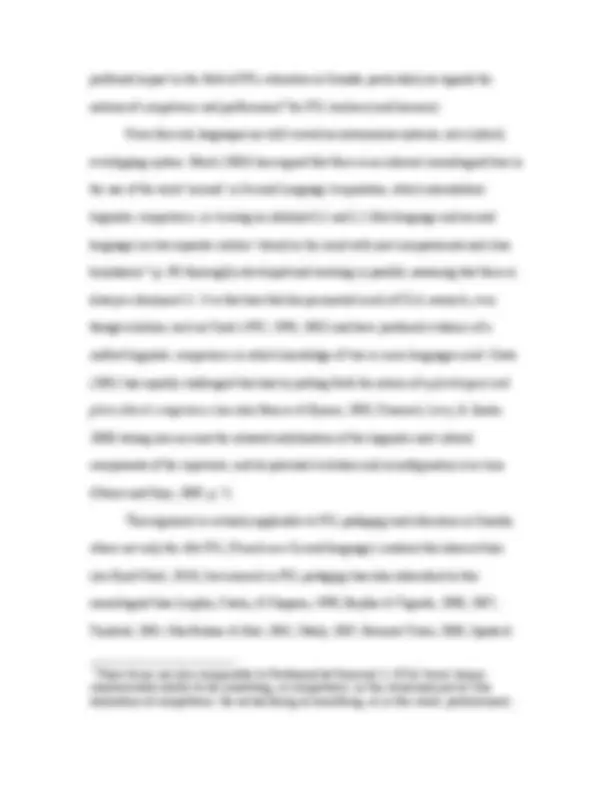
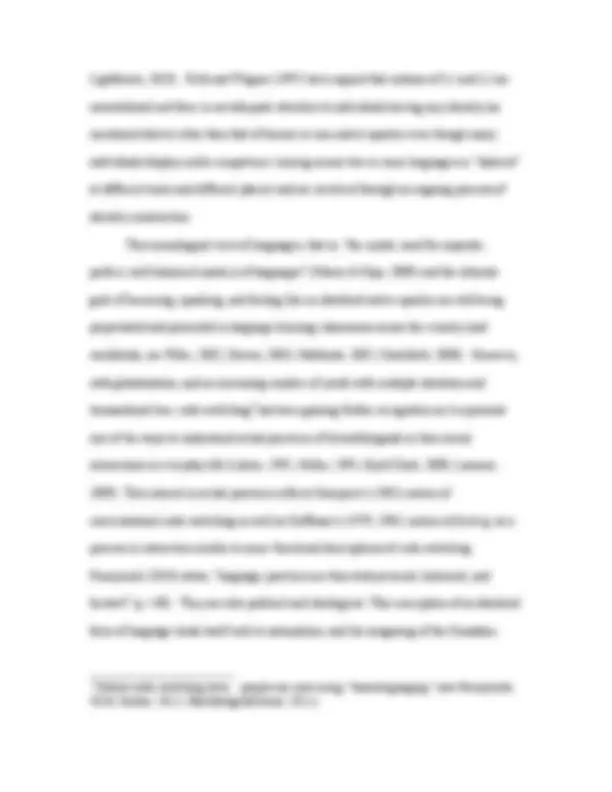
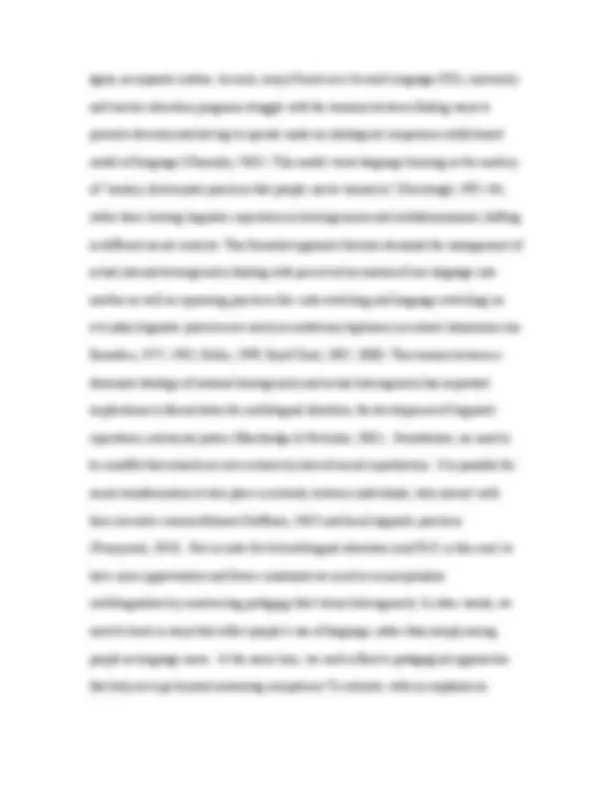
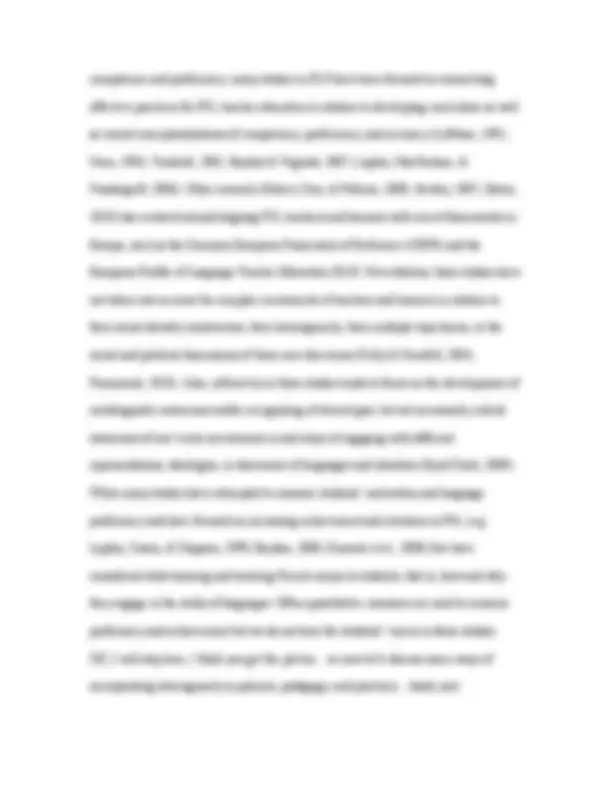



Study with the several resources on Docsity

Earn points by helping other students or get them with a premium plan


Prepare for your exams
Study with the several resources on Docsity

Earn points to download
Earn points by helping other students or get them with a premium plan
Community
Ask the community for help and clear up your study doubts
Discover the best universities in your country according to Docsity users
Free resources
Download our free guides on studying techniques, anxiety management strategies, and thesis advice from Docsity tutors
The role of language in internationalizing and globalizing education, with a focus on French language pedagogy in Canada. It explores the impact of language policies on producing effective human capital and perpetuating dominant discourses of standardization, bilingualism, and notions of competence through processes of globalization and internationalization. The document also examines the historical conceptualization of language and the idealized form of language in Canada, and how it has impacted language teaching and learning. It concludes by discussing the implications of such discourses for study abroad contexts and international exchange programs.
Typology: Slides
1 / 10

This page cannot be seen from the preview
Don't miss anything!







Introduction: Across varied contexts, educational institutions and organizations have been influenced by global shifts and processes associated with internationalization. While many researchers are invested in finding new ways to theorize international education as well as the global research imagination, the role of language in internationalizing and globalizing is often overlooked, assumed, or not considered at all. Language, whether seen as a discourse, social construction or semiotic system, plays a critical role in processes of globalizing and internationalizing education as Fairclough states: “it is partly language that is globalizing and globalized” (2006:3). This is particularly significant when governments, like the Canadian one, aim to produce effective human capital (Byram, 2008); in other words, well developed, citizens of the world in this new knowledge economy--citizens who are not only deemed culturally sensitive, but also multilingual. In this paper I want to center my discussion around how language is positioned in Canada as it relates to language teaching, French language pedagogy (FLP), in particular. In Canada, federal initiatives regarding Official bilingualism are often directed at language teachers to contribute to producing effective human capital (Byram, 2008) as stated above. Nevertheless, official language policies in Canada continue to reproduce solutions based on the language-nation-state ideology (Hobsbawm, 1990; Lamarre, 2010) reminiscent of the 1960s and 70s (e.g. one language, one people). My main point is to demonstrate the importance of recognizing linguistic heterogeneity and to be critical of how language is being used by certain stakeholders to reproduce and perpetuate dominant discourses of standardization, bilingualism and notions of competence through processes
of globalization and internationalization. As a researcher who specializes in both language education and globalization, it is important to look at the impact of such discourses of language on people in their everyday lives? So, the first thing to consider, is how has language been conceptualized in the past and how do such conceptualizations impact the present and future? Finally, in illustrating this example of language education and the ideological, socio-affective, and political position of language in Canada, we can discuss such implications (e.g. the myth of the “native, idealized” speaker) for study abroad contexts and international exchange programs. The Grand Illusion: Imagining Languages as Rationale Systems and as Ideal Forms In order to make sense of some of the ideologies that have shaped teaching language(s) in Canada, and in order to understand some of the recent developments in the field, we need to consider two things: First, FLP has to be understood in its relationship to Official French-English bilingualism and the ways in which language(s) has been represented in the Canadian-nation state; Second, we must take into account the ways in which language has been researched and historically conceptualized. When we look at fields, such as Second Language Acquisition (SLA), we can see that Formalist approaches to languages have tended to dominate thinking or ways of thinking about language teaching and learning. It has been only within the last twenty years that more sociocultural approaches to languages and identities have started to gain serious recognition (Norton Pierce, 1995; Block, 1996, 2003; Firth & Wagner, 1997; Hall, 1997; Lantolf, 1996; van Lier, 1994; Pennycook, 2004; Byrd Clark, 2009). One of the main points made by Firth and Wagner (1997) was that SLA research was dominated by a tradition of psycholinguistic research that viewed individuals primarily as non-native
profound impact in the field of FSL education in Canada, particularly as regards the notions of competence and performance 1 for FSL teachers (and learners). From this end, languages are still viewed as autonomous systems, not a hybrid, overlapping system. Block (2003) has argued that there is an inherent monolingual bias in the use of the word ‘second’ in Second Language Acquisition, which essentializes linguistic competence, in viewing an idealized L1 and L2 (first language and second language) as two separate entities “stored in the mind with neat compartments and clear boundaries” (p. 39) thoroughly developed and working in parallel, assuming that there is always a dominant L1. It is this bias that has permeated much of SLA research, even though scholars, such as Cook (1992, 1996, 2002) and have produced evidence of a unified linguistic competence in which knowledge of two or more languages exist. Coste (2001) has equally challenged this bias by putting forth the notion of a plurilingual and pluricultural competence (see also Beacco & Byram, 2003; Kramsch, Levy, & Zarate,
Lightbown, 2010). Firth and Wagner (1997) have argued that notions of L1 and L2 are essentialized and there is not adequate attention to individuals having any identity (as mentioned above) other than that of learner or non-native speaker even though many individuals display multi-competence (mixing across two or more languages or “dialects” at different times and different places) and are involved through an ongoing process of identity construction. This monolingual view of languages; that is, “the mystic need for separate, perfect, well-balanced mastery of languages” (Moore & Gajo, 2009) and the ultimate goal of becoming, speaking, and feeling like an idealized native speaker are still being perpetuated and promoted in language learning classrooms across the country (and worldwide, see Piller, 2002; Davies, 2003; Mahboob, 2005; Castellotti, 2008). However, with globalization, and an increasing number of youth with multiple identities and transnational ties, code-switching^2 has been gaining further recognition as it represents one of the ways to understand actual practices of bi/multilinguals in their social interactions in everyday life (Labrie, 1991; Heller, 1992; Byrd Clark, 2008; Lamarre, 2009). This interest in actual practices reflects Gumperz’s (1982) notion of conversational code-switching as well as Goffman’s (1979, 1981) notion of footing , as a process in interaction similar to some functional descriptions of code switching. Pennycook (2010) states, “language practices are thus always social, historical, and located” (p. 140). They are also political and ideological. This conception of an idealized form of language lends itself well to nationalism, and the imagining of the Canadian- (^2) Define code-switching here…people are now using “translanguaging” (see Pennycook, 2010; Sarkar, 2011; Blackledge&Crease, 2011).
to both multicultural groups and English and French minority communities (particularistic), thus recognizing the specificity of the cultural and linguistic community to which individuals belong. However, recognizing difference can become problematic because an individual may belong to several cultural and linguistic communities (Quell,
again, as separate entities. As such, many French as a Second Language (FSL) university and teacher education programs struggle with the tensions between finding ways to promote diversity and having to operate under an ideological competence-skills based model of language (Chomsky, 1965). This model views language learning as the mastery of “unitary, determinate practices that people can be trained in” (Fairclough, 1992:44), rather than viewing linguistic repertoires as heterogeneous and multidimensional, shifting in different social contexts. This formalist approach likewise demands the management of actual internal heterogeneity (dealing with perceived incursions of one language into another as well as repressing practices like code-switching and language switching) as everyday linguistic practices are rarely accorded any legitimacy in school classrooms (see Bourdieu, 1977, 1982; Heller, 1999; Byrd Clark, 2007, 2008). This tension between a dominant ideology of national homogeneity and actual heterogeneity has important implications in liberal states for multilingual identities, the development of linguistic repertoires, and social justice (Blackledge & Pavlenko, 2001). Nonetheless, we need to be mindful that schools are not exclusively sites of social reproduction. It is possible for social transformation to take place in schools, between individuals, who interact with their inventive resourcefulness (Goffman, 1967) and local linguistic practices (Pennycook, 2010). But in order for bi/multilingual education (and FLP, in this case) to have more opportunities and fewer constraints we need to reconceptualize multilingualism by constructing pedagogy that values heterogeneity. In other words, we need to teach in ways that reflect people’s use of language, rather than simply seeing people as language users. At the same time, we need reflexive pedagogical approaches that help us to go beyond measuring competence To reiterate, with an emphasis on